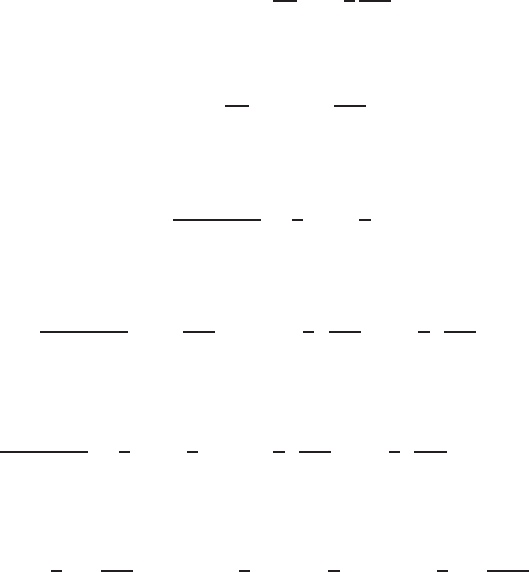Biringen S., Chow C.-Y. An Introduction to Computational Fluid Mechanics by Example
Подождите немного. Документ загружается.


252 NUMERICAL SOLUTION OF THE INCOMPRESSIBLE NAVIER-STOKES EQUATION
For this equation, both the convective and diffusive stability requirements must
be satisfied. Obtained from the von Neumann analysis, these two conditions are,
respectively,
C =
u
max
t
x
≤ 1 (4.4.14)
d ≡ ν
t
x
2
≤
1
2
(4.4.15)
For practical purposes, we choose t from the smaller of the two. It is
interesting to note that t obtained from (4.4.15) decreases quadratically with
x, whereas according to (4.4.14), t decreases linearly with x. Therefore,
in regions of the flow where field variables rapidly vary, and where it would
be necessary to use very fine mesh with small x, the time step restrictions
imposed by (4.4.15) will be much more severe. To relax the t restriction due
to the explicit differencing of the diffusion term, it is generally preferred to
use an implicit scheme. For the linear diffusion term with constant viscosity,
implicit finite differences result in a banded system of linear equations that can
be solved very efficiently by direct elimination methods.
In Section 3.6, the implicit Crank-Nicolson (CN) method was introduced as a
second-order accurate (in time and in space) formula for solving parabolic partial
difference equations. This method is unconditionally stable (in the von Neumann
sense) for both advective and diffusive equations. To recapitulate the derivation in
Section 3.6, let us consider the model diffusion equation with constant transport
coefficient ν,
∂u
∂t
= ν
∂
2
u
∂x
2
(4.4.16)
Using “trapezoidal” differencing with Taylor series,
u
n+1
i
= u
n
i
+(u
t
)
n
i
t +(u
tt
)
n
i
t
2
2
+(u
ttt
)
n
i
t
3
6
+··· (4.4.17)
u
n
i
= u
n+1
i
−(u
t
)
n+1
i
t +(u
tt
)
n+1
i
t
2
2
−(u
ttt
)
n+1
i
t
3
6
+··· (4.4.18)
Subtracting (4.4.18) from (4.4.17), we obtain
u
n+1
i
−u
n
i
= u
n
i
−u
n+1
i
+(u
t
)
n
i
t +(u
t
)
n+1
i
t +(u
tt
)
n
i
t
2
2
−(u
tt
)
n+1
i
t
2
2
+O(t
3
) (4.4.19)
Again using Taylor series,
(u
tt
)
n+1
i
= (u
tt
)
n
i
+t(u
ttt
)
n
i
+O(t
2
) (4.4.20)

PRIMITIVE VARIABLE FORMULATION: ALGORITHMIC CONSIDERATIONS 253
can be obtained. Substitution of (4.4.20) into (4.4.19) gives
2
u
n+1
i
−u
n
i
= (u
t
)
n
i
t + (u
t
)
n+1
i
t +(u
tt
)
n
i
t
2
2
−(u
tt
)
n
i
t
2
2
−(u
ttt
)
n
i
t
3
2
(4.4.21)
After canceling and dividing by t, equation (4.4.21) can be written as
u
n+1
i
−u
n
i
t
=
1
2
(u
t
)
n+1
i
+
1
2
(u
t
)
n
i
+O(t
2
) (4.4.22)
Substituting directly from (4.4.16) for u
t
= νu
xx
,
u
n+1
i
−u
n
i
t
=
1
2
ν
∂
2
u
∂x
2
n+1
+
1
2
ν
∂
2
u
∂x
2
n
+O
t
2
, x
2
(4.4.23)
Spatial derivatives will be replaced by second-order central differences to main-
tain second-order accuracy in both space and time:
u
n+1
i
−u
n
i
t
=
1
2
ν
x
2
u
n+1
i+1
−2u
n+1
i
+u
n+1
i−1
+u
n
i+1
−2u
n
i
+u
n
i−1
+O(t
2
, x
2
) (4.4.24)
Simplifying this expression, we obtain
−
d
2
u
n+1
i+1
+(1 +d)u
n+1
i
−
d
2
u
n+1
i−1
=
d
2
u
n
i+1
−(d − 1)u
n+1
i
+
d
2
u
n
i−1
(4.4.25)
with the diffusion coefficient defined as d = νt/x
2
. Equation (4.4.25) shows
that the finite difference formula leads to a tridiagonal matrix equation which can
be solved by an efficient direct solver.
Now let us apply the Crank-Nicolson method to the convection–diffusion
equation (4.4.11):
u
n+1
i
−u
n
i
t
+
1
2
u
∂u
∂x
n+1
−
1
2
ν
∂
2
u
∂x
2
n+1
=
1
2
ν
∂
2
u
∂x
2
n
−
1
2
u
∂u
∂x
n
(4.4.26)
The second term on the left-hand side of this equation is the nonlinear convective
term discretized at the advanced time level (n + 1) and, with central differences,
can be written as
1
2
u
∂u
∂x
n+1
=
1
4x
u
n+1
i
u
n+1
i+1
−u
n+1
i−1
(4.4.27)
resulting in a nonlinear difference equation. The solution of such an equation
requires local linearization, which can be obtained by lagging the coefficient
term u
n+1
i
(predictor step), and using the new value in the coefficient during the

254 NUMERICAL SOLUTION OF THE INCOMPRESSIBLE NAVIER-STOKES EQUATION
corrector step; one iteration step is generally sufficient (Tannehill et al., 1997). It is
apparent that because the predictor step has to go through the whole computation
cycle, this linearization will be accomplished at increasing computational cost,
which can be significant for multidimensional large-scale problems. We also note
that in the von Neumann sense, the Crank-Nicolson method is unconditionally
stable for the convection–diffusion equation.
A very useful and highly popular scheme for the incompressible Navier-Stokes
equation is the semi-implicit AB-CN method, which uses the explicit Adams-
Bashforth (AB) method on the nonlinear convective terms, and the implicit
Crank-Nicolson (CN) method on the diffusion terms. One important advantage of
this approach is that due to the explicit AB method on the nonlinear convective
terms, no iteration (or linearization) is required, as the resulting finite-difference
equation is linear; hence, the calculation is considerably cheaper than with fully
implicit methods. The AB-CN method is especially suitable for viscous wall-
bounded problems, in which the implicit CN method on the viscous diffusion
terms relaxes the viscous stability time-step restriction.
Considering (4.4.11), we write the convective term in conservative form, and
define a function H ,
H =−u
∂u
∂x
=−
1
2
∂u
2
∂x
(4.4.28)
so that (4.4.11) can be written as
∂u
∂t
= H +ν
∂
2
u
∂x
2
(4.4.29)
Using the AB method for H , we obtain
u
n+1
i
−u
n
i
t
=
3
2
H
n
i
−
1
2
H
n−1
i
(4.4.30)
For the diffusion term we use the CN method such that
u
n+1
i
−u
n
i
t
=
ν
∂
2
u
∂x
2
n+1/2
=
1
2
ν
∂
2
u
∂x
2
n+1
+
1
2
ν
∂
2
u
∂x
2
n
(4.4.31)
Now we can advance (4.4.29) in time, which obtains
u
n+1
i
−u
n
i
t
=
3
2
H
n
i
−
1
2
H
n−1
i
+
1
2
ν
∂
2
u
∂x
2
n+1
+
1
2
ν
∂
2
u
∂x
2
n
+O(t
2
, x
2
)
(4.4.32)
Rearranging (4.4.32),
u
n+1
i
−
1
2
νt
∂
2
u
∂x
2
n+1
= u
n
i
+
3
2
tH
n
i
−
1
2
tH
n−1
i
+
1
2
νt
∂
2
u
n
∂x
2
≡ RHS
n
i
(4.4.33)

PRIMITIVE VARIABLE FORMULATION: ALGORITHMIC CONSIDERATIONS 255
Using central differences, and defining the numerical diffusion coefficient as
d = νt/x
2
as before, we obtain
−
1
2
du
n+1
i−1
+(d + 1)u
n+1
i
−
1
2
du
n+1
i+1
= RHS
n
i
(4.4.34)
Now we calculate the RHS term:
RHS
n
i
=
1
2
d
u
n
i−1
+u
n
i+1
+u
n
i
(1 − d) +
1
2
t
3H
n
i
−H
n−1
i
with
H
n
i
=−
1
2
(u
2
)
n
i+1
−(u
2
)
n
i−1
2x
H
n−1
i
=−
1
2
(u
2
)
n−1
i+1
−(u
2
)
n−1
i−1
2x
(4.4.35)
The solution proceeds as follows:
1. Generate the second level initial data at time level n by using the explicit
Euler method on the convective term; the CN method can be used for the
diffusion term.
2. Evaluate H
n
i
and H
n−1
i
using second-order central differences.
3. Evaluate RHS
n
i
from (4.4.35).
4. Calculate the coefficients of the left-hand-side of (4.4.34).
5. Impose the boundary conditions.
6. Solve the resulting tridiagonal matrix equation.
7. Go back to step 2; continue to advance the solution in time.
8. In assigning the allowable time step, the only restriction is the convec-
tive restriction. Therefore, t must be chosen to ensure that the Courant
number, C ≤ 1, is strictly obeyed as in (4.4.14).
As we have observed in Sections (2.2) and (3.3), discretization of the diffu-
sion term by second-order central finite differences results in a linear system of
equations where the coefficient matrix is tridiagonal. The subroutine TRID solves
this system of equations using an efficient adaptation of Gaussian elimination
exploiting the sparseness of the matrix. Here we will introduce a similar algo-
rithm called the Thomas algorithm, which also requires only 3n storage, where n
is the number of the unknowns in the problem (that is, the number of grid points).
We will also provide an algorithm for the LU decomposition method for tridiag-
onal matrices, which is more efficient when one solves many linear equations in
sequence with the same coefficient matrix, such as in time-dependent solutions
of the parabolic diffusion equation.

256 NUMERICAL SOLUTION OF THE INCOMPRESSIBLE NAVIER-STOKES EQUATION
Thomas Algorithm
We consider the following generic system of linear equations, where the coeffi-
cient matrix A is tridiagonal:
Ax = f (4.4.36)
In this equation, x is the solution vector and f is the right-hand-side vector.
As we have seen in Section 2.2, the coefficient matrix A can be written as
A =
⎡
⎢
⎢
⎢
⎢
⎢
⎢
⎢
⎢
⎢
⎢
⎣
a
1
c
1
00··· 00
b
2
a
2
c
2
0 ··· 00
0 b
3
a
3
c
3
··· 00
00
.
.
.
.
.
.
.
.
.
00
.
.
.
.
.
.
.
.
.
.
.
.
.
.
.
.
.
.
0
00··· 0 b
n−1
a
n−1
c
n−1
00··· ··· 0 b
n
a
n
⎤
⎥
⎥
⎥
⎥
⎥
⎥
⎥
⎥
⎥
⎥
⎦
(4.4.37)
The Thomas algorithm, which is an efficient adaptation of Gaussian elimination
to tridiagonal matrices, can be written as follows.
Forward elimination:
a
j
= a
j
−
b
j
a
j−1
c
j−1
(4.4.38)
f
j
= f
j
−
b
j
a
j−1
f
j−1
j = 2, ..., n (4.4.39)
Back substitution:
x
n
= f
n
/a
n
(4.4.40)
x
n−j
= (f
n−j
−c
n−j
x
n−j+1
)/a
n−j
j = 1, ..., n −1 (4.4.41)
The number of operations is proportional to n, and is much more computationally
efficient than Gaussian elimination on a full matrix where the number of opera-
tions is proportional to n
3
(Ferziger, 1998). Also, during forward elimination, the
diagonal elements of the original coefficient matrix are overwritten, and, unless
the algorithm is modified to preserve the diagonal, at each step the diagonal (a
j
)
has to be redefined.
LU Decomposition
Another efficient way of solving the tridiagonal system (4.4.36) is by LU decom-
position. Let us consider a 4 ×4 tridiagonal coefficient matrix, A:
A =
⎡
⎢
⎢
⎣
a
1
c
1
00
b
2
a
2
c
2
0
0 b
3
a
3
c
3
00b
4
a
4
⎤
⎥
⎥
⎦
(4.4.42)
PRIMITIVE VARIABLE FORMULATION: ALGORITHMIC CONSIDERATIONS 257
We intend to decompose the A matrix into two matrices, L and U as defined
below:
L =
⎡
⎢
⎢
⎣
l
1
000
b
2
l
2
00
0 b
3
l
3
0
0 b
4
l
4
⎤
⎥
⎥
⎦
, U =
⎡
⎢
⎢
⎣
1 u
1
00
01u
2
0
00 1u
3
0001
⎤
⎥
⎥
⎦
LU =
⎡
⎢
⎢
⎣
l
1
l
1
u
1
00
b
2
b
2
u
1
+l
2
l
2
u
2
0
0 b
3
b
3
u
2
+l
3
l
3
u
3
b
4
b
4
u
3
+l
4
⎤
⎥
⎥
⎦
(4.4.43)
Comparing LU element by element with the A matrix, we solve for u
j
and l
j
.
Noting that the subdiagonal b
j
is the same in A and L matrices, L and U can be
obtained from the following algorithm:
l
1
= a
1
u
j−1
= c
j−1
/l
j−1
(4.4.44)
l
j
= a
j
−b
j
u
j−1
, j = 2, 3, ..., n −1, n
The solution of (4.4.36) can then be obtained as
Ax = f
A = LU → find L and U
(4.4.45)
Once L and U are calculated by using (4.4.44), the solution proceeds:
LUx = f
Lz = f → find z (4.4.46)
Ux = z → find x
The last two steps of (4.4.46) can be written in algorithmic form as
z
1
= f
1
/l
1
z
j
= ( f
j
−b
j
z
j−1
)/l
j
j = 2, 3, ..., n
(4.4.47)
From which one can obtain the solution vector, x:
x
n
= z
n
x
j
= z
j
−u
j
x
j+1
, j = n −1, n −2, ..., 1 (4.4.48)
The LU decomposition will be especially efficient when the system has con-
stant coefficients so that the decomposition will be done only once during the
solution. The L and U matrices can be stored at the first time step, and during
the subsequent steps only the back-substitution steps (4.4.47) and (4.4.48) will
be performed, thus decreasing computer time necessary to obtain the solution.

258 NUMERICAL SOLUTION OF THE INCOMPRESSIBLE NAVIER-STOKES EQUATION
Problem 4.6 MATLAB script 4.3 solves the one-dimensional, nonlinear, vis-
cous Burgers equation using the AB-CN semi-implicit method; the tridiago-
nal linear system of finite-difference equations resulting from the implicit time
advancement of the viscous diffusion term is solved using the Thomas algorithm,
with the same initial/boundary conditions as described in Problem 2.12. Solve
the same problem using LU decomposition instead of the Thomas algortithm.
4.5 PRIMITIVE VARIABLE FORMULATION: NUMERICAL
INTEGRATION OF THE NAVIER-STOKES EQUATION
In this section, we apply the methods developed in Section 4.4 to the numeri-
cal integration of the two-dimensional, incompressible, time-dependent Navier-
Stokes equation written in terms of primitive variables on a uniform grid. We
will introduce the fractional time-step algorithm and staggered mesh systems and
outline a method for solving for the pressure (gradient) that satisfies mass conser-
vation to machine accuracy at the advanced time level. Putting all these together,
we will develop an efficient solver for the driven cavity problem.
Let us consider the two-dimensional, time-dependent, incompressible Navier-
Stokes and the continuity equations nondimensionalized by the characteristic
length and velocity scales, L and U
0
, respectively:
∇ · V = 0 (4.5.1)
∂V
∂t
+V · ∇V =−∇P + Re
−1
∇
2
V (4.5.2)
Here, P = p/ρ,wherep is thermodynamic pressure, and using (4.5.1) we define
H = V · ∇V = ∇ · (VV) (4.5.3)
The Reynolds number Re is defined as
Re =
U
o
L
ν
(4.5.4)
When integrating (4.5.1) and (4.5.2), it is imperative that mass conservation
equation (4.5.1) is satisfied to machine zero at every point in the integration
domain. An efficient way to ensure this constraint is by the use of the time-
splitting (or the fractional time step) method. Of the several variants of this
method (Chorin, 1968; Orszag and Kells, 1981; Kim and Moin, 1985), we
will adopt the one used by Huser and Biringen (1992) in their simulations of
shear-driven cavity flows. Another predictor–corrector algorithm for incompress-
ible flows is the SIMPLE algorithm (semi-implicit method for pressure-linked
equations) advanced by Patankar and Spalding (1972) and Patankar (1980). This
method is based on a finite-volume discretizationonastaggeredgrid,andhas
been widely used in computational fluid mechanics and heat transfer.

PRIMITIVE VARIABLE FORMULATION: NUMERICAL INTEGRATION 259
According to the time-splitting method, in the first step (predictor step) from
t
n
to
ˆ
t, the pressure gradient is neglected and the resulting equation is solved:
ˆ
V − V
n
t
=−
3
2
H
n
+
1
2
H
n−1
+
1
2Re
∇
2
(
ˆ
V + V
n
) (4.5.5)
We note that in (4.5.5) temporal discretization is done with the Crank-Nicolson
scheme on the viscous diffusion terms and with the Adams-Bashforth method on
the convective terms. Next, advancing (4.5.2) from t
n
to t
n+1
, we obtain
V
n+1
−V
n
t
=−
3
2
H
n
+
1
2
H
n−1
+
1
2Re
∇
2
V
n+1
+∇
2
V
n
−∇P
n+1
(4.5.6)
Subtracting (4.5.5) from (4.5.6) gives the corrector step for updating V
n+1
:
V
n+1
−
ˆ
V
t
=
1
2Re
∇
2
V
n+1
−∇
2
ˆ
V
−∇P
n+1
.
=−∇φ
n+1
(4.5.7)
The term ∇φ
n+1
, which is the gradient of the scalar quantity φ
n+1
, contains the
pressure gradient term as well as the residual viscous terms, and simply is used as
an operator to ensure zero divergence of the velocity field at time level (n + 1).
This is accomplished by taking the divergence of (4.5.7):
∇ · V
n+1
−∇ ·
ˆ
V
t
=−∇
2
φ
n+1
(4.5.8)
Now, enforcing continuity at time level (n + 1),
∇ · V
n+1
= 0 (4.5.9)
equation (4.5.8) gives
∇ ·
ˆ
V
t
=∇
2
φ
n+1
(4.5.10)
The solution process can be constructed as follows.
Step 1. Solve for
ˆ
V from (4.5.5):
ˆ
V
t
−
1
2Re
∇
2
ˆ
V =−
3
2
H
n
+
1
2
H
n−1
+
1
2Re
∇
2
V
n
+
V
n
t
(4.5.11)
Multiplying through by t,thex component of (4.5.11) can be written
in Cartesian coordinates (x, y, z ):
ˆu
i, j
−
t
2Re
∇
2
ˆu
i, j
=−
3t
2
(H
n
u
)
i, j
+
t
2
(H
n−1
u
)
i, j
+
t
2Re
∇
2
u
n
i, j
+u
n
i, j
(4.5.12)

260 NUMERICAL SOLUTION OF THE INCOMPRESSIBLE NAVIER-STOKES EQUATION
The subscript u (or v) indicates that the quantity appears in the u
(or v)-momentum equation. Now using second-order central differ-
ences with x = y = h, we obtain
β
1
ˆu
i, j
−(ˆu
i+1, j
−2ˆu
i, j
+ ˆu
i−1, j
) −( ˆu
i, j +1
−2ˆu
i, j
+ ˆu
i, j −1
)
= (RHS
n
u
)
i, j
(4.5.13)
The quantities β
1
and (RHS
n
u
) are defined as
β
−1
1
≡
t
2Re h
2
(RHS
n
u
)
i, j
=−
3tβ
1
2
(H
n
u
)
i, j
+
tβ
1
2
(H
n−1
u
)
i, j
+
u
n
i+1, j
−2u
n
+u
n
i−1, j
+
u
n
i, j +1
−2u
n
i, j
+u
n
i, j −1
+β
1
u
n
i, j
(4.5.14)
Equation (4.5.13) can be written in compact form:
−ˆu
i+1, j
− ˆu
i−1, j
− ˆu
i, j +1
− ˆu
i, j −1
+(4 + β
1
) ˆu
i, j
= (RHS
n
u
)
i, j
(4.5.15)
We note that this is an elliptic (Helmholtz ) equation in space, and can
be solved with any of the methods introduced previously in Section
2.8. For small mesh sizes, around 100 ×100 or so, direct methods
based on Gaussian elimination (for example, the LU decomposition
method) can be used efficiently.
A similar elliptic equation will be solved for the v component of
equation (4.5.11).
Step 2. Solve for φ
n+1
using (4.5.10) with second-order central differences.
This equation is written as
φ
n+1
i+1, j
+φ
n+1
i−1, j
+φ
n+1
i, j +1
+φ
n+1
i, j −1
−4φ
n+1
i, j
=
h
2
t
∂ ˆu
∂x
+
∂ ˆv
∂y
(4.5.16)
The right-hand side of this elliptic equation involves the evaluation of
the divergence of the velocity field at the intermediate time step, which
will be done in conjunction with the staggered mesh system that will
be introduced later in this section. Equation (4.5.16) can be solved with
any of the iterative elliptic solvers mentioned in Section 2.8 as well
as with a direct solver. Special care must be devoted to the solution
of this equation, as all the boundary conditions are of Neumann type;
that is, they are imposed on the normal gradients of φ, thus making
the system of equations (4.5.16) linearly dependent. We will explore
how to alleviate this problem later in this section.

PRIMITIVE VARIABLE FORMULATION: NUMERICAL INTEGRATION 261
Step 3. The velocity field will be updated using (4.5.7):
V
n+1
−
ˆ
V
t
=−∇φ
n+1
(4.5.17)
Accordingly, the velocity components at the advanced time level are
given as
V
n+1
=
ˆ
V −(t)∇φ
n+1
u
n+1
i+1/2, j
= ˆu
n
i+1/2, j
−(t)
∂φ
∂x
n+1
i, j
(4.5.18)
v
n+1
i, j +1/2
= ˆv
n
i, j +1/2
−(t)
∂φ
∂y
n+1
i, j
The indices i + 1/2andj + 1/2 refer to the u and v grids in the staggered
mesh system. Spatial discretization will be done on a staggered mesh, following
the marker-and-cell (MAC) method of Harlow and Welch (1965). It was shown
by Bernard and Thompson (1984) that staggered mesh arrangements provide
a stronger coupling between velocity and pressure thus eliminating some high
frequency oscillations that may exist at high Reynolds number computations. In
addition, mass conservation is satisfied across a grid not at a grid point, and
finally, pressure boundary conditions are obtained from the velocity boundary
conditions. One should also recall that because of the staggered arrangement,
velocity boundary conditions require specification of velocities at one grid point
outside of the boundary.
To illustrate the pressure–velocity coupling, we will consider the one-
dimensional equation of motion, retaining only the temporal term and the
pressure gradient term:
∂u
∂t
=−
∂P
∂x
(4.5.19)
and also the one-dimensional continuity equation:
∂u
∂x
= 0 (4.5.20)
Using implicit time integration on a collocated grid (Figure 4.5.1) to calculate
P at time level (n +1), and with second-order central differences in space, we
obtain
u
n+1
i
= u
n
i
−
t
2x
P
n+1
i+1
−P
n+1
i−1
(4.5.21)
i − 2 i − 1
i
i + 1
(u
i
, P
i
)
i + 2
FIGURE 4.5.1 Velocity and pressure nodes on a collocated grid.
